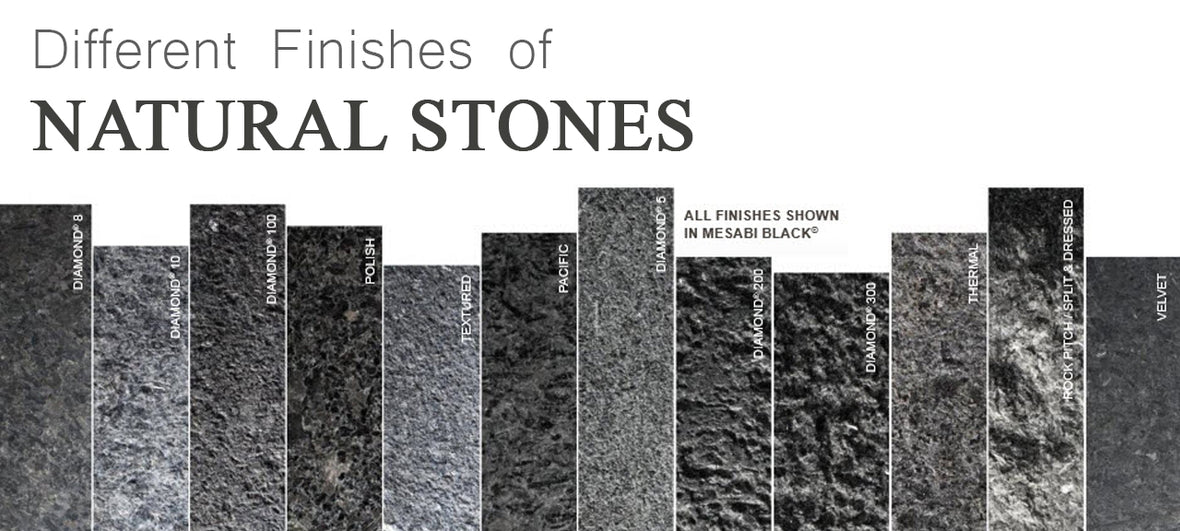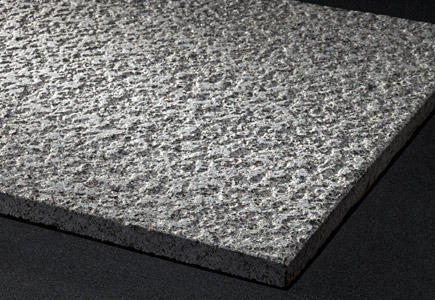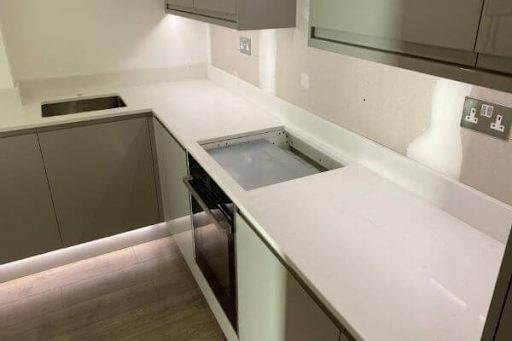
Different Finishes of Natural Stones
Sammy Chris1 comment
Natural stones like granite, marble, limestone, quartzite, and sandstone are created by nature. These stones are mined from the earth and subjected to processing at the stone factories. The solid blocks of the stone are mined and cut into slabs and then sent for finishing in factories. The finishing process makes the stones fit and suitable for different construction purposes.

Significance of Finishing
The finishing process involves a mechanical technique that gives the stone different types of finishes for both interior and exterior design works. The functionality of the stone can be clearly redefined by the textural modification achieved in the finishing process. The surface finishing of the natural stone plays an important role in creating stones that are not slippery, light-reflecting surfaces, toning down the natural chrome, and sometimes softening or intensifying hues of cream and white. From times of old, natural stones have paved their way into homes, offices, and historical monuments for utilitarian and decorative purposes. The different texture of the natural stone enhances the longevity and aesthetics of the design.
Natural Finishing
The natural stone slab installed without any finishing processor in the absence of any treatment is called a rough finish. The stones are quarried from the mountains and sliced into slabs of desirable dimension. Then the finishing process begins for the stones which become suitable for cladding or cobblestones. The types of finishing available in natural finishing are Riven Finishing and Sawn finishing. In Riven finishing, the surface is designed for shining slate and quartzite tiles. The finish is derived from the point of division at which the blocks are dissected. The finish has other popular names like river cleft, natural cleft, or split face. This uneven surface is suitable for floor designs, the patterns on this design are not engineered but created naturally while mined. Certain granites and marbles are available with clefting which are limited for wall installations and pavements.

Riven Finishing
sawn finishing is achieved by cutting the stone into tiles with a gang saw or block cutter. Granite and sandstone come in this finish and are used for decorating the garden, patio, and pavements. A split-face finish is created by splitting stone by hand or machine to achieve a natural-looking quarry texture. The back is flat with an uneven front. These stones vary from one to another.
Mechanical Finishing
Mechanical finishing renders a smooth and glossy finish with different textures. This brings out the attributes of the stone to light. The finishing textures of natural stones available in mechanical finishing are of three types. They are Honed, Polished, and Satin finish.
Honed finishing is an ideal choice for a matted and smooth surface with lighter shades. The stones like granite, marble, limestone, slate, and travertine are used for busy floors and stairs. Sanding and grinding create a smooth finish but are not glossy or reflective. This finish is a great pick for ease of maintenance, busy traffic applications. It has a satin-smooth surface with a minimal reflection of light. Honed surfaces serve their purpose as the exterior in warm surroundings, tabletops, residential flooring, and interior wall covering. Implementing different grades of abrasiveness under engineering conditions.

(Honed Finishing)
Polished finishing is concerned with a glossy surface that comes from the use of abrasive materials. It is suitable for polished marble, travertine, granite, and limestone to emphasize natural colors and grains. The sanding and buffing process leads to glossy sheen or mirror-like reflective surfaces. Polishing is subjective to crystallized stones. The porosity of the natural stone slab is affected by polishing treatment. It naturally induces the color and veining pattern of the stone. A polished finish gives a smooth, seamless, and reflective appearance to the stone. This is highly assigned for busy areas like an office Reception desk or Enquiry and Help desk, but the popular areas of application for a polished surface are interior or exterior cladding, interior or exterior paving fireplace surrounds, domestic and commercial worktops, tabletops, bench tops, and kitchen countertops. A polished reflective surface brings out the colors in the stone. The intensity of polishing is dependent upon the number of mineral deposits. These are highly recommended for wall covering but avoided as flooring due to the slippery nature of the finish.

Sandblasted Finishing for a textured surface with a softened gloss, the uneven but tidy appearance is created using a high-pressure blast of sand to the natural stone. This sandblasted finish is suitable for high traffic areas when the treatment involves a high-pressure water jet with sand on the stone resulting in a finish that softens the chrome and characteristics of the stone.
Satin Finishing is found between polished and honed finishes that are not matte and reflective. This is not a very common finish.
Impact Finishing
Impact Finishing was a result of creating varieties of textures, this finish type offers an irregular and rough texture for having resistance against slip. Stones processed with this finish need more care and attention. The Natural stone finish in the impact option comes with the following types:
Bush-hammered Finishing gives an anti-skip finished look, Leather finishing for a worktop that has smooth and slip resistance properties.

(Bush-hammered Finishing)
Tumbled Finishing for a natural stone with an aged appearance, a leathered finish is created by brushing the slab with various brushes. The result of this process is an undulating, soft, seamless, and smooth-looking surface.

(Tumbled finishing)
Rigato Finishing to render the surface an undeviating pattern
Tooled Finishing as an option to the bush-hammered finish
Brushed Finishing for a rough appearance
Water Finishing to wash softer particle
Flamed Finishing for a rough-textured surface, it is commonly known for external use to reduce slippery surface concern. This type of finish is created by introducing increased temperature flame to the stone surface which results in a shock and causes internally embedded crystals to break or fracture creating a deeply textured surface for exterior construction applications. This is a useful technique to hide the flaws like imperfections and tonal variations on the natural stone. In stones with golden tallow hues like honey granite, the oxidation iron saturates the yellow to turn pale orange or pink creating a dramatic theme of colors. River wash finishing to make tiles non-slippery, Letano finishing to intensify inherent chromatic spectrum, shot blasted finishing for work surfaces having some aging properties

(flamed granite finishing)
Chemical Finishing
Chemical finishing is achieved by the addition of chemicals to the natural stone. This finish can transform the appearance and texture of the stone. The four types of finishes available with chemical finishing are Acid wash, Epoxy treatment, Meshed finish, and Protective treatment.
Acid Wash is a type of finish where the kitchen worktop surface achieves a stunning antique appearance. The stone is tumbled with pebbles and sand to produce an aged and weathered finish. Tumbling and acid washing are applied to the stone causing etches on the slab. This treatment is primarily applied to tone down the color scheme of the natural stone but the surface is immediately subjected to mechanical wire brushing to smoothen the surface and restore the color to the stone.
Epoxy Treatment comes in handy for enhancing the endurance of kitchen countertops.
Meshed Finish is suited to the natural stone surface where defect slabs are made durable.
Protective Treatment is another type of finish for shielding the surfaces from graffiti and oil-based substances.
With the range of textures defining stone finishes, it could be overwhelming to choose the right finish for your project as it is an important part of your Residential or commercial project. Selecting the appropriate theme protects the theme of the structural design, aesthetics, durability, and best practices for maintenance of your natural stone worktops, kitchen countertops, and floors.



Comments (1)
Amazing blog thanks for sharing the information about different finishes of natural stones.